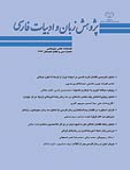تحليل رابطه گفتمان اخلاقي متن با شيوه بيان در دو اثر غلامحسین ساعدی
محورهای موضوعی : Research in Iranian classical literature
1 -
کلید واژه: گفتمان اخلاقي روايت غلامحسين ساعدی آشغالدونی آرامش در حضور دیگران,
چکیده مقاله :
خوانش متن ادبي با رويكرد نقد اخلاقي ميتواند بر اساس تشخيص مفاهيم و مضامين اخلاقي متن يا درك رابطۀ گفتمان اخلاقي متن با ساختار زيباييشناسانه آن صورت پذيرد. در رويكردهاي جدید نقد بر این نکته تأکید میشود که متن هنري بر دلالتهاي ضمني استوار است و معناي آن، پنهان است. سرشت اثر ادبی اقتضا میکند که شيوه بيان بيشتر از موضوع مورد توجه قرار گیرد. پرسش پژوهش اين است كه نويسنده يك داستان ادبي، چگونه درك اخلاقي خود و مخاطب را با شيوههاي روايتپردازي عمق ميبخشد. مورد مطالعه، دو داستان از آثار غلامحسين ساعدي است و از نقد و تحليل پژوهشهاي انجام يافته دربارۀ اين نويسنده چند نتيجه حاصل ميشود: 1- اصليترين حوزههاي معنايي كه ساعدي به آنها توجه داشته، مضامين سياسي، مسائل اجتماعي و روحي و رواني است. در اين حوزههاي معنايي، درون مايۀ اصلي آثار او پيوند مسائل اجتماعي با آسيبهاي فردي و ريشه داشتن فساد اخلاقي در اجتماع است كه رگههايي از اخلاق ماركسيستي را بازمينمايد. 2- ساعدي در تلفيق شيوههاي مدرن داستاننويسي با آرمانهاي سياسي و اجتماعي، گفتمان اخلاقي خود را در بيان زيباييشناسانه و شگردهاي روايي توليد كرده است. 3- واقعگرايي، ويژگي روساخت داستانهاي ساعدي است و تلفيق آن با نمادگرايي در ساختار دروني روايت، جنبۀ اخلاقي يا غير اخلاقي رويدادها را تقويت ميكند. 4- شخصيت در بيشتر داستانها بر طرح غالب است و تأثير اجتماع بيمار بر فساد اخلاقي فرد در ترسيم كنش و واكنش شخصيتها و تجسم ذهن و روان پيچيده آنها نشان داده ميشود. 5- فضاسازي و تجسم نمايشي بر شگردهاي بلاغي و زباني غالب است و تأثير منفي يك كنش غير اخلاقي از طريق فضاسازي به مخاطب القا ميشود.
A moral critical approach to reading a literary text can be achieved by recognizing the moral concepts and themes in the text, or by grasping the relationship between the moral discourse of the text and its aesthetic structure. New approaches in criticism emphasize that the artistic text is based on connotations, and the meaning of the text is hidden. For this, the method of expression in literary text is of more interest than the subject. This research seeks the answer to the question that how the writer of a literary story deepens his/her own and his/her audience’s moral understanding through narrative methods. The subject of the study is Gholam-Hossein Saedi’s works. By analyzing and reviewing the researches about this writer, several conclusions can be drawn: 1. the main semantic domains to which Saedi paid attention are political, social, and psychological. In these semantic domains, the basic theme of his works is the connection of social issues with damages to individuals as well as the immorality caused by society showing traces of Marxist morality; 2. In integrating new story writing methods with political and social ideals, Saedi formed his moral discourse by aesthetic expression and narrative devices; 3. Realism is the feature of Saedi's stories’ surface structure, and integrating this feature with symbolism in the inner structure of narrative enriches the moral or immoral aspects of events; 4. In most stories, character dominates the plot, and the effect of a sick society on the immorality of a person can be depicted by tracing the characters’ actions and reactions, and visualizing their complicated minds and souls; 5. Dramatic visualization dominates rhetorical and verbal ploys, and the negative influences of an immoral action are suggested by creating an atmosphere. At the end of this article, examples of Saedi’s moral discourse and his method of expression have been presented.

